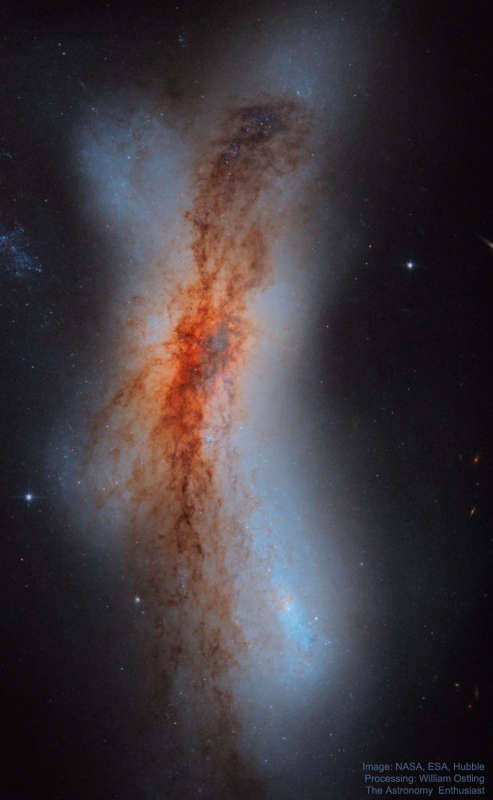Credit & Copyright: NASA,
ESA, Hubble;
Processing & Copyright:
William Ostling
(The Astronomy Enthusiast)
Explanation:
Is this one galaxy or two?
The jumble of stars, gas, and
dust that is
NGC 520 is now thought
to incorporate the remains of two separate disk galaxies.
A defining component of
NGC 520 --
as seen in great detail in the
featured image from the
Hubble Space Telescope -- is its
band of intricately interlaced dust
running vertically down the spine of the
colliding galaxies.
A similar looking collision might be expected in a few billion
years when our disk
Milky Way Galaxy to
collides with our large-disk galactic neighbor
Andromeda (M31).
The collision that defines
NGC 520
started about 300 million years ago.
Also known as Arp 157, NGC 520 lies about 100 million light years
distant, spans about 100 thousand
light years,
and can be seen with a small telescope toward the
constellation of the Fish
(Pisces).
Although the speeds of stars in
NGC 520 are fast, the distances are
so vast that the
battling pair
will surely not change its shape noticeably during our lifetimes.
1999 2000 2001 2002 2003 2004 2005 2006 2007 2008 2009 2010 2011 2012 2013 2014 2015 2016 2017 2018 2019 2020 2021 2022 2023 2024 2025 |
Yanvar' Fevral' Mart Aprel' Mai Iyun' Iyul' Avgust Sentyabr' Oktyabr' Noyabr' Dekabr' |
NASA Web Site Statements, Warnings, and Disclaimers
NASA Official: Jay Norris. Specific rights apply.
A service of: LHEA at NASA / GSFC
& Michigan Tech. U.
|
Publikacii s klyuchevymi slovami:
colliding galaxies - stalkivayushiesya galaktiki
Publikacii so slovami: colliding galaxies - stalkivayushiesya galaktiki | |
Sm. takzhe:
Vse publikacii na tu zhe temu >> | |
